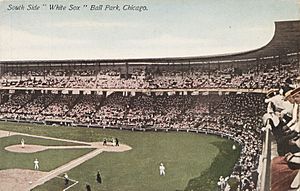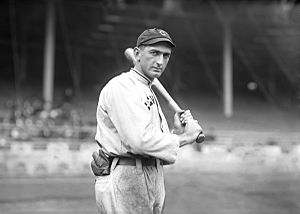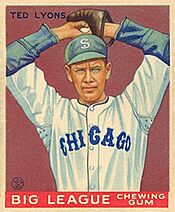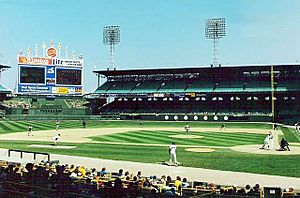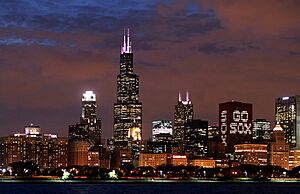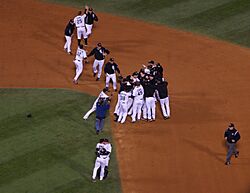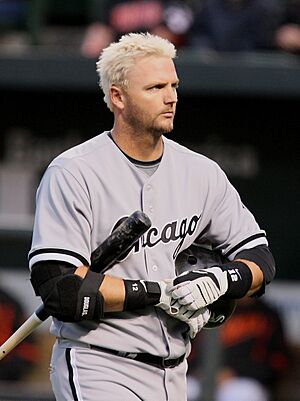History of the Chicago White Sox facts for kids
The Chicago White Sox are a professional baseball team located on the South Side of Chicago. They are one of the oldest teams in Major League Baseball (MLB), starting in Chicago in 1901. The White Sox have won six American League championships and three World Series titles, with their most recent win in 2005.
Contents
- How the Team Started
- Early Years (1901–1917)
- The "Black Sox" Era (1918–1920)
- Tough Times (1922–1950)
- The "Go-Go Era" (1950–1967)
- Threats of Moving (1968–1975)
- Veeck's Return and the "South Side Hitmen" (1976–1981)
- The Reinsdorf Era Begins (1982–2004)
- The Drought Ends: 2005 World Series Champions!
- After the World Series (2006–Present)
- 2006 Season
- 2007 Season
- 2008 Season: Central Champs Again
- 2009 Season
- 2010 Season
- 2011 Season: "All In"
- 2012 Season
- 2013 Season
- 2014 Season
- 2015 Season
- 2016 Season
- 2017 Season: Starting a Rebuild
- 2018 Season
- 2019 Season
- 2020 Season: Back in the Playoffs!
- 2021 Season: Division Champs Again
- 2022 Season: A Step Back
- 2023 Season: More Struggles
- 2024 Season: Worst Start Ever
- Images for kids
- See also
How the Team Started
The team began as a minor league club called the Sioux City Cornhuskers in Sioux City, Iowa. They played in the Western League. In 1893, Ban Johnson became the league's president. The Cornhuskers won the Western League Pennant in 1894.
After the 1894 season, a former baseball star named Charles Comiskey bought the Sioux City team. He moved it to Saint Paul, Minnesota, and renamed it the St. Paul Saints. The Saints were quite successful for the next five years.
In 1900, the Western League changed its name to the American League. It was still a minor league at this time. The National League, which was the main league, allowed the American League to have a team in Chicago. Comiskey moved his St. Paul team to Chicago's Near South Side. He renamed them the White Stockings, a nickname once used by the Chicago Cubs. The White Stockings won the 1900 American League pennant. After this season, the American League decided to become a major league, just like the National League.
Early Years (1901–1917)
After joining the major leagues, the White Stockings quickly became strong. They won the American League's first major league championship in 1901. Newspaper writers in Chicago started calling them the "White Sox" to save space in headlines. The team officially adopted the shorter name in 1904. The White Sox became known for their great pitching and strong defense, led by pitcher Ed Walsh.
The "Hitless Wonders" of 1906
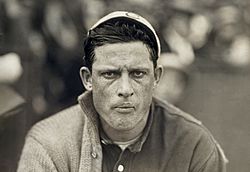
In 1906, the White Sox won the pennant again. They faced their city rivals, the Chicago Cubs, in the 1906 World Series. The Cubs were huge favorites because they had won a record 116 games that season. Also, the White Sox had the lowest batting average in the American League, meaning they didn't hit the ball very well.
However, in a big surprise, the White Sox won the World Series in six games! This upset gave them bragging rights over the Cubs. To this day, the 1906 White Sox are remembered as "the Hitless Wonders" because they won without being great hitters.
For the next ten years, the White Sox had mixed results. But during this time, they gathered talented players like catcher Ray Schalk, infielder Buck Weaver, and pitchers Eddie Cicotte, Red Faber, and Reb Russell. In 1915, Pants Rowland became the manager. The team added star players like outfielder Shoeless Joe Jackson, second baseman Eddie Collins, and outfielder Happy Felsch.
The 1917 World Champions
In 1917, the White Sox added first baseman Chick Gandil and shortstop Swede Risberg, completing their championship team. They had an amazing season, winning 100 games and the pennant by nine games. This is still a team record for wins. Their offense was strong, and their pitching staff, led by Cicotte, Williams, Faber, and Russell, was the best in the league.
1917 World Series Victory
The White Sox played against the New York Giants in the 1917 World Series. The White Sox won the first two games in Chicago. In Game 1, Felsch hit a home run that helped them win.
The Giants fought back, winning Games 3 and 4 in New York, shutting out the White Sox in both games. The series was tied 2-2. Back in Chicago for Game 5, the White Sox were losing, but they made a big comeback in the late innings to win 8-5.
In Game 6, the White Sox took an early lead. With another strong pitching performance from Faber, they won 4-2 and became World Champions! Eddie Collins was a hitting star, and Cicotte and Faber pitched almost every inning of the series.
The "Black Sox" Era (1918–1920)
After a slower year in 1918 due to World War I, the White Sox bounced back to win the pennant in 1919. They were expected to easily beat the Cincinnati Reds in the 1919 World Series.
However, before the series began, rumors spread that some players were planning to lose games on purpose for money. The White Sox lost to the Reds in eight games. These rumors continued into the 1920 season, even as the White Sox played well. Later, it was revealed that several White Sox players had indeed agreed to "fix" the 1919 World Series. Eight players, including stars like Shoeless Joe Jackson and Eddie Cicotte, were banned from baseball forever. This event became known as the "Black Sox Scandal."
1920 Season
The 1920 White Sox team was very strong, with four pitchers who won 20 games each. However, the scandal's rumors and later revelations deeply affected the team.
Tough Times (1922–1950)
Losing seven of their best players because of the "Black Sox" scandal severely weakened the team. The White Sox struggled for many years, finishing near the bottom of the league. They didn't have a winning record again until 1936. During these years, players like third baseman Willie Kamm, shortstop Luke Appling, and pitcher Ted Lyons were stars, but the team as a whole wasn't strong enough to compete for championships.
The White Sox almost got Babe Ruth before he became a legend with the Yankees! They offered to trade Shoeless Joe Jackson for him, but the New York Yankees offered more money. This period saw the Yankees rise to power in baseball, partly because other teams, like the White Sox, lost their star players.
The team became more competitive under manager Jimmy Dykes from 1934 to 1946. However, they didn't fully recover until the 1950s.
The "Go-Go Era" (1950–1967)
After the original owner, Charles Comiskey, died in 1931, his family continued to own the team. In 1959, the team was finally sold to a new group led by Bill Veeck.
In the 1950s, the White Sox started to play much better. They focused on speed and amazing defense. Star player Minnie Miñoso, who was the team's first black player in 1951, was a great example of this style. He led the league in stolen bases and played excellent defense. The team also added rookie shortstop Luis Aparicio in 1956 and manager Al López in 1957. They joined other great players like Nellie Fox at second base and pitchers Billy Pierce and Virgil Trucks. The White Sox led the American League in stolen bases every year from 1951 to 1961.
Even though the White Sox had winning records every year from 1951 to 1967, the powerful Yankees often kept them from winning the pennant. The White Sox finished in second place five times during this period.
1959: Pennant Winners!
In 1959, the White Sox finally won their first pennant in 40 years! This was thanks to players like manager Lopez, Aparicio, Fox (who won the league MVP award), and pitcher Early Wynn (who won the Cy Young Award). They also added slugger Ted Kluszewski for the final push.
1959 World Series
After winning the pennant, Chicago's mayor, a White Sox fan, ordered the city's air raid sirens to go off in celebration! Many people were confused at first, thinking it was a Cold War alert.
The White Sox won Game 1 of the 1959 World Series against the Los Angeles Dodgers with a big 11-0 victory. However, the Dodgers won three of the next four games and clinched their first World Series title since moving to Los Angeles. Game 5 had over 92,000 fans, the most ever for a World Series game. The White Sox won that game, but the Dodgers won the series in Game 6 at Comiskey Park.
Veeck's Fun Ownership
When Bill Veeck took over in 1959, Comiskey Park became a place of exciting promotions. He installed fireworks in the scoreboard that exploded after home runs and victories. In 1960, the White Sox became the first sports team to put players' last names on the back of their jerseys, another Veeck idea. Players liked playing for Veeck because he was friendly and understood them.
Close Calls in the 1960s
The 1964 season was frustrating. The White Sox won 98 games, but finished just one game behind the Yankees. In 1967, the White Sox were in one of the closest pennant races ever, with four teams fighting for the title until the very last weekend. The White Sox finished fourth, just three games behind the winner.
Threats of Moving (1968–1975)
In 1968, the White Sox played some home games in Milwaukee, Wisconsin, to see if Milwaukee could support a major league team. These games were very popular, drawing huge crowds. This led to talks about moving the White Sox to Milwaukee permanently. The American League didn't want to lose Chicago, a big city, so they blocked the sale.
The White Sox had a very bad season in 1970, winning only 56 games. In 1972, they had a brief comeback with slugger Dick Allen winning the MVP award, but injuries hurt the team.
In 1975, there was another plan to move the White Sox to Seattle. The Oakland Athletics would then move to Chicago. But this plan fell apart when Bill Veeck bought the White Sox again. Instead, the Seattle Mariners were created in 1977, bringing baseball back to Seattle.
Veeck's Return and the "South Side Hitmen" (1976–1981)
On December 10, 1975, Bill Veeck bought the White Sox again. He promised to make the team exciting. Besides his usual promotions, Veeck introduced retro uniforms and even shorts for the players (which they only wore three times!). The 1976 team was one of the worst, winning only 64 games.
Veeck tried a strategy called "rent-a-player," where he acquired star players who were in the last year of their contracts. He hoped they would play extra hard to earn a big contract later. This didn't work well, as the team had to give up young players for veterans who often left after one season.
1977: The South Side Hitmen
The 1977 season was memorable. The team, nicknamed the "South Side Hitmen" by fans and the press, hit a team record 192 home runs. They were in first place in August and finished third with 90 wins. They also drew a record number of fans to Comiskey Park. Manager Bob Lemon was named AL Manager of the Year.
1979–1981
The next few years were tough, with many losses. A bright spot came in 1979 when Veeck hired 34-year-old coach Tony LaRussa as manager. La Russa went on to have a Hall of Fame career.
Veeck started building up the team's minor league system, which produced future stars like Harold Baines and Britt Burns. But Veeck couldn't afford to compete with richer teams. By 1980, the White Sox needed new owners.
The Reinsdorf Era Begins (1982–2004)
In 1981, Jerry Reinsdorf and Eddie Einhorn bought the team. They quickly showed they wanted to win by signing star catcher Carlton Fisk and power hitter Greg Luzinski. They also kept young manager Tony La Russa.
1983: "Winning Ugly"
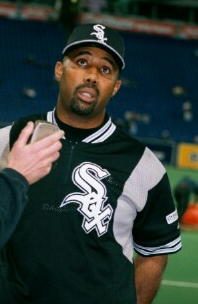
In 1983, the White Sox had their best season in a long time. After a slow start, they added speedy player Julio Cruz. They then went on an amazing run, winning 60 of their last 85 games to clinch the AL West title. Manager Tony La Russa won his first Manager of the Year award.
A rival manager called their style "winning ugly" because they won with scrappy play rather than just strong hitting or pitching. White Sox fans loved the phrase and made it the team slogan. However, they lost to the powerful Baltimore Orioles in the AL Championship Series.
1985–1989
The team struggled again for the rest of the 1980s. In 1985, shortstop Ozzie Guillén joined the team and won the AL Rookie of the Year award. In 1986, La Russa was fired after a poor start. The team wouldn't compete for a title again until 1990, which was the last year in the old Comiskey Park.
The 1990s: "Good Guys Wear Black"
1990 Season
In 1990, many young players became stars. Closer Bobby Thigpen set a record with 57 saves. First baseman Frank Thomas, pitchers Alex Fernandez and Jack McDowell, and third baseman Robin Ventura all made a big impact. The White Sox won 94 games but finished behind the strong Oakland Athletics.
On July 11, 1990, the White Sox played a "Turn Back the Clock" game, wearing their 1917 uniforms. This was the first such game in MLB history and started a popular tradition. A new ballpark, later known as U.S. Cellular Field, opened in 1991.
1993 Season
The team reached the ALCS in 1993. Led by Thomas, Ventura, McDowell (who won the Cy Young Award), and closer Roberto Hernández, the White Sox won their division. However, they lost to the defending World Champion Toronto Blue Jays in six games.
1994 Season
The White Sox were leading their division when the 1994 season ended early due to a players' strike.
Late 1990s
The team remained somewhat consistent through the late 1990s, often finishing in second place. In 1997, they made a controversial "White Flag Trade," trading away good players for younger prospects. While fans were upset at the time, this move helped the team build for future success.
Early 2000s
2000: "The Kids Can Play"
Under Manager Jerry Manuel, the White Sox had a very talented team in 2000. Their slogan was "The Kids Can Play." They won 95 games and the AL Central division title. The team scored a lot of runs, led by Frank Thomas, Magglio Ordóñez, Paul Konerko, Carlos Lee, and José Valentín.
However, like in 1983 and 1993, the 2000 team couldn't win in the playoffs. They were swept by the Seattle Mariners in the Division Series.
2003–2004
In 2003, Comiskey Park was renamed U.S. Cellular Field, a move that many fans disliked. The All-Star game was held there for the first time. In 2004, former White Sox shortstop Ozzie Guillen became the team's new manager.
The Drought Ends: 2005 World Series Champions!
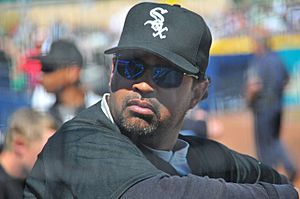
The changes made a big difference in 2005. The White Sox had one of the best records in baseball for most of the year. They won the AL Central Division title, their first since 2000. They finished with 99 wins, tying their 1983 record. Their great record also gave them home field advantage throughout the playoffs.
2005 ALDS
In the 2005 American League Division Series, the White Sox faced the defending World Series champions, the Boston Red Sox. The White Sox swept the Red Sox in three games! They won the first two games at home, and then clinched the series in Boston. In Game 2, a controversial play where the catcher didn't cleanly catch a third strike allowed A.J. Pierzynski to reach base, leading to a game-winning home run. In Game 3, pitcher Orlando Hernández came into a tough situation with the bases loaded and no outs, but he got out of it without allowing a run.
2005 ALCS
The White Sox then played the Los Angeles Angels of Anaheim in the ALCS. The Angels won Game 1, which was the White Sox's only playoff loss that year.
Game 2 had another controversial ending. With the score tied in the ninth inning, A. J. Pierzynski appeared to strike out. But the umpire ruled that the catcher didn't catch the ball, so Pierzynski ran to first base. A pinch-runner stole second, and then Joe Crede hit a double to win the game for the White Sox! This win was also special because Mark Buehrle pitched a complete game, allowing only one run.
After that exciting win, the White Sox traveled to Anaheim. Their starting pitchers, Jon Garland, Freddy García, and José Contreras, each pitched complete game victories, meaning they pitched the entire game without needing relief pitchers. This was an amazing feat in modern baseball! The White Sox won the series and their first American League pennant since 1959. Slugger Paul Konerko was named the ALCS MVP.
2005 World Series
The White Sox advanced to the 2005 World Series, where they faced the Houston Astros. This was a special moment for longtime White Sox star Frank Thomas, who finally reached the World Series in his 16th season, though he couldn't play due to injury.
In Game 1, the White Sox won 5-3. Joe Crede made some incredible defensive plays at third base.
Game 2 was thrilling. The White Sox were down, but a controversial play where Jermaine Dye was hit by a pitch (though replays showed it hit his bat) loaded the bases. Paul Konerko then hit a grand slam to give Chicago the lead! The Astros tied it in the ninth, but Scott Podsednik hit a walk-off home run to win the game 7-6. Podsednik hadn't hit a home run all regular season!
The series moved to Houston for Game 3. The White Sox came back from a 4-0 deficit to win 7-5 in 14 innings, the longest World Series game ever. Former Astro Geoff Blum hit the tie-breaking home run.
Game 4 was a close pitching duel. Jermaine Dye singled in the winning run in the eighth inning. In the bottom of the ninth, shortstop Juan Uribe made a spectacular diving catch into the stands for an out. On the very next play, Uribe threw out the final batter at first base, clinching the World Series for the White Sox! It was their first World Series title since 1917.
Here's the 1-2 pitch to Palmeiro. A ground ball, past Jenks, up the middle of the infield, Uribe has it, he throws- OUT! OUT! A WHITE SOX WINNER! AND A WORLD CHAMPIONSHIP! The White Sox have won the World Series, and they're mobbing each other on the field!
Dye was named the World Series MVP. The White Sox finished the playoffs with an incredible 11-1 record, one of the best in MLB history. Their 8-game winning streak in the playoffs tied a major league record.
After the World Series (2006–Present)
2006 Season
In 2006, the White Sox had another good season, winning 90 games. However, they couldn't make the playoffs to defend their title. Manager Ozzie Guillén and six White Sox players were selected for the All-Star Game. The team also set new attendance records, with many sellouts.
2007 Season
On April 18, 2007, Mark Buehrle pitched a no-hitter against the Texas Rangers. He almost pitched a perfect game, allowing only one walk. Later that season, Jim Thome hit his 500th career home run. Closer Bobby Jenks also tied an MLB record by retiring 41 batters in a row. Despite these highlights, the team struggled with injuries and hitting, finishing fourth in their division.
2008 Season: Central Champs Again
On August 14, 2008, Jim Thome, Paul Konerko, Alexei Ramírez, and Juan Uribe hit four consecutive home runs in one inning, a rare feat in baseball history.
On September 29, Alexei Ramírez hit his fourth grand slam of the season, setting a new rookie record. This helped the White Sox qualify for a special one-game playoff against the Minnesota Twins for the AL Central title.
On September 30, 2008, the White Sox won the tiebreaker game 1-0 against the Twins. John Danks pitched an amazing game, and Bobby Jenks closed it out. The only run came from a home run by Jim Thome. This was the lowest scoring tiebreaker game in MLB history. The White Sox then lost to the Tampa Bay Rays in the ALDS.
2009 Season
On July 23, 2009, White Sox pitcher Mark Buehrle threw a perfect game against the Tampa Bay Rays. This means he pitched the entire game without any opposing player reaching base. It was his second no-hitter and the second perfect game in White Sox history. After the game, President Barack Obama called Buehrle to congratulate him! Just five days later, Buehrle set a new MLB record by retiring 45 batters in a row.
2010 Season
On Opening Day 2010, Mark Buehrle made an amazing defensive play, picking up a ball with his glove and flipping it backwards to first baseman Paul Konerko for an out. Konerko also set a franchise record for home runs in April with 11. On August 29, the White Sox honored Frank Thomas by retiring his jersey number and adding his image to the outfield wall.
2011 Season: "All In"
The White Sox signed big free agents like Adam Dunn and re-signed Paul Konerko. They finished the season with a losing record. A bronze statue of Frank Thomas was unveiled. Manager Ozzie Guillén left the team at the end of the season and was replaced by former White Sox third baseman Robin Ventura.
2012 Season
On April 21, 2012, Philip Humber threw the third perfect game in White Sox history against the Seattle Mariners. The White Sox led their division for much of the season but lost many games late and finished second to the Detroit Tigers.
2013 Season
The White Sox had a very cold Opening Day in 2013, tying a 1907 record. They won the game 1-0. However, the team finished last in their division, losing 99 games, their worst record since 1976.
2014 Season
In 2014, the White Sox finished fourth in their division. First baseman José Abreu won the American League Rookie of the Year award, leading the team in batting average, home runs, and RBIs.
2015 Season
The White Sox made some big player signings before the 2015 season, but it didn't help much. They finished fourth in their division again.
2016 Season
The White Sox started 2016 very strong, leading the American League in early May. But their success didn't last, and they finished fourth in their division. Manager Robin Ventura resigned and was replaced by Rick Renteria.
2017 Season: Starting a Rebuild
In 2017, the White Sox began to trade away their star players for young prospects, hoping to build a strong team for the future. They traded pitchers Chris Sale and José Quintana, and outfielder Adam Eaton. The team finished fourth in their division.
2018 Season
The 2018 season was tough for the White Sox, as they finished with 100 losses, their worst record since 1970.
2019 Season
In 2019, the White Sox improved, finishing third in their division. José Abreu led the American League with 123 RBIs.
2020 Season: Back in the Playoffs!
In 2020, after years of rebuilding, the White Sox made big moves, signing players like catcher Yasmani Grandal and pitchers Dallas Keuchel and Liam Hendriks. In the shortened season due to the pandemic, the team finished second in their division and made the playoffs for the first time since 2008! They lost in the Wild Card Series to the Oakland Athletics. José Abreu won the American League MVP award, becoming only the fourth White Sox player to do so.
2021 Season: Division Champs Again
Before the 2021 season, the White Sox brought back Tony La Russa as manager, making him the oldest manager in MLB at 76. They also traded for pitcher Lance Lynn and signed closer Liam Hendriks. On August 12, the White Sox played in the first ever Field of Dreams game in Iowa against the New York Yankees, winning on a walk-off home run by Tim Anderson. On September 23, the White Sox clinched the AL Central Division again, their first time winning back-to-back playoff berths in franchise history. They finished with 93 wins but lost to the Houston Astros in the ALDS.
2022 Season: A Step Back
The White Sox made more player moves in 2022, but they didn't improve. They finished the season with an even record of 81 wins and 81 losses, placing second in their division.
2023 Season: More Struggles
Before the 2023 season, Tony La Russa stepped down as manager due to health issues. The White Sox hired Pedro Grifol as their new manager and signed some new players. However, the season was a disaster, with many losses and injuries. By late July, the team traded away many key players for prospects, starting another rebuild. They finished the season with 101 losses, one of the worst records in franchise history.
2024 Season: Worst Start Ever
In 2024, the White Sox had their worst start to a season ever, losing 14 games in a row and having one of the worst records in MLB history through their first 25 games.
Images for kids
-
Ed Walsh was a dominant starter for the White Sox from 1904 to 1916 and holds the lowest career ERA in Major League history.
-
Shoeless Joe Jackson was a White Sox outfielder from 1915 to 1920, and still holds franchise records for both triples in a season and career batting average.
See also


